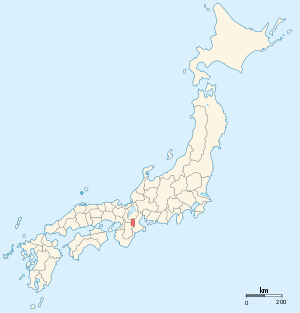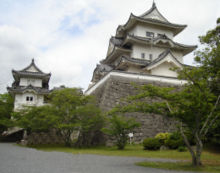
Iga Province
Encyclopedia

Mie Prefecture
is a prefecture of Japan which is part of the Kansai regions on Honshū island. The capital is the city of Tsu.- History :Until the Meiji Restoration, Mie prefecture was known as Ise Province and Iga Province....
. It was sometimes called . Iga bordered on Ise
Ise Province
or was a province of Japan including most of modern Mie Prefecture. Ise bordered Iga, Kii, Mino, Ōmi, Owari, Shima, and Yamato Provinces.The ancient provincial capital was at Suzuka...
, Ōmi
Omi Province
is an old province of Japan, which today comprises Shiga Prefecture. It was one of the provinces that made up the Tōsandō circuit. It is nicknamed as .Lake Biwa, Japan's largest lake, is located at the center of the province...
, Yamato
Yamato Province
was a province of Japan, located in Kinai, corresponding to present-day Nara Prefecture in Honshū. It was also called . At first, the name was written with one different character , and for about ten years after 737, this was revised to use more desirable characters . The final revision was made in...
, and Yamashiro
Yamashiro Province
was a province of Japan, located in Kinai. It overlaps the southern part of modern Kyoto Prefecture on Honshū. Aliases include , the rare , and . It is classified as an upper province in the Engishiki....
Provinces.
Geography
The Iga province is a small mountain ringed basin (the Ueno basin) in the center of Japan's Kansai region, on the island of HonshūHonshu
is the largest island of Japan. The nation's main island, it is south of Hokkaido across the Tsugaru Strait, north of Shikoku across the Inland Sea, and northeast of Kyushu across the Kanmon Strait...
.
Iga was one of fifteen ancient provinces which made up the . This land area was one of five geographical regions within what was known as the gokishichidō
Gokishichido
was the name for ancient administrative units organized in Japan during the Asuka Period , as part of a legal and governmental system borrowed from the Chinese...
system -- an organized way of parsing the Japanese islands into five commonly understood elements. The Tōkaidō region was situated along the southeastern edge of Honshū
Honshu
is the largest island of Japan. The nation's main island, it is south of Hokkaido across the Tsugaru Strait, north of Shikoku across the Inland Sea, and northeast of Kyushu across the Kanmon Strait...
, its name literally means 'Eastern Sea Way'.
The term Tōkaidō also refers to a series of roads that connected the capitals (国府 kokufu) of each of the provinces of the region, including small Iga. Historically, Iga Province was rather inaccessible due to extremely poor road conditions. However, it is now relatively easy to access from nearby Nara
Nara, Nara
is the capital city of Nara Prefecture in the Kansai region of Japan. The city occupies the northern part of Nara Prefecture, directly bordering Kyoto Prefecture...
and Kyoto
Kyoto
is a city in the central part of the island of Honshū, Japan. It has a population close to 1.5 million. Formerly the imperial capital of Japan, it is now the capital of Kyoto Prefecture, as well as a major part of the Osaka-Kobe-Kyoto metropolitan area.-History:...
, as well as the larger cities of Osaka
Osaka
is a city in the Kansai region of Japan's main island of Honshu, a designated city under the Local Autonomy Law, the capital city of Osaka Prefecture and also the biggest part of Keihanshin area, which is represented by three major cities of Japan, Kyoto, Osaka and Kobe...
and Nagoya.
History

Ueno, Mie
was a city located in Mie, Japan. The city was founded on September 10, 1941.On November 1, 2004 Ueno was merged with the old town of Iga, the town of Ayama, the villages of Ōyamada and Shimagahara, all from Ayama District, and the town of Aoyama, from Naga District, to form the new city of Iga.In...
was the location of Iga-Ueno Castle
Iga Ueno Castle
, also known as and , is a Japanese castle located in Iga, Mie Prefecture, Japan.- History :Construction on Iga Ueno Castle began in 1585 by the command of Takigawa Katsutoshi. However, the honmaru, or innermost bailey, as well as the tenshu, or donjon, upon which the modern reconstruction was...
.
The Iga Province is particularly famous for its clan of ninja
Ninja
A or was a covert agent or mercenary of feudal Japan specializing in unorthodox arts of war. The functions of the ninja included espionage, sabotage, infiltration, and assassination, as well as open combat in certain situations...
, its most notable member being a samurai, Hattori Hanzō
Hattori Hanzo
, also known as , was a famous samurai and ninja master of the Sengoku era, credited with saving the life of Tokugawa Ieyasu and then helping him to become the ruler of united Japan. Today, he is often a subject of modern popular culture.-Biography:...
. Both the Iga and Kōka
Koka, Shiga
is a city located in the southern part of Shiga Prefecture, Japan....
provinces are considered the birthplace of ninjutsu
Ninjutsu
or may be:*the arts associated with espionage and assassination in feudal Japan, see Ninja*modern schools of martial arts claiming to be based in these traditions, see Modern Schools of Ninjutsu*fictional depictions, see Ninja in popular culture...
. It was also the birthplace of haiku
Haiku
' , plural haiku, is a very short form of Japanese poetry typically characterised by three qualities:* The essence of haiku is "cutting"...
poet Matsuo Bashō
Matsuo Basho
, born , then , was the most famous poet of the Edo period in Japan. During his lifetime, Bashō was recognized for his works in the collaborative haikai no renga form; today, after centuries of commentary, he is recognized as a master of brief and clear haiku...
.
During the early Muromachi Period
Muromachi period
The is a division of Japanese history running from approximately 1336 to 1573. The period marks the governance of the Muromachi or Ashikaga shogunate, which was officially established in 1338 by the first Muromachi shogun, Ashikaga Takauji, two years after the brief Kemmu restoration of imperial...
the Iga Province became effectively independent from their feudal rulers and established a form of republic. The Iga Republic was called Iga Sokoku Ikki (伊賀惣国一揆) in Japanese.
In 1581, two years after a failed invasion led by his son, the warlord Oda Nobunaga
Oda Nobunaga
was the initiator of the unification of Japan under the shogunate in the late 16th century, which ruled Japan until the Meiji Restoration in 1868. He was also a major daimyo during the Sengoku period of Japanese history. His opus was continued, completed and finalized by his successors Toyotomi...
launched a massive invasion of Iga, attacking from six directions with a force of 40,000 to 60,000 men. After ruthlessly slaughtering great numbers of the inhabitants of the Iga region, Oda Nobunaga then declared a cease-fire which allowed some of the Iga ninja to escape. It was, however, the end of the independent Iga Republic.

